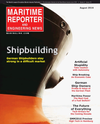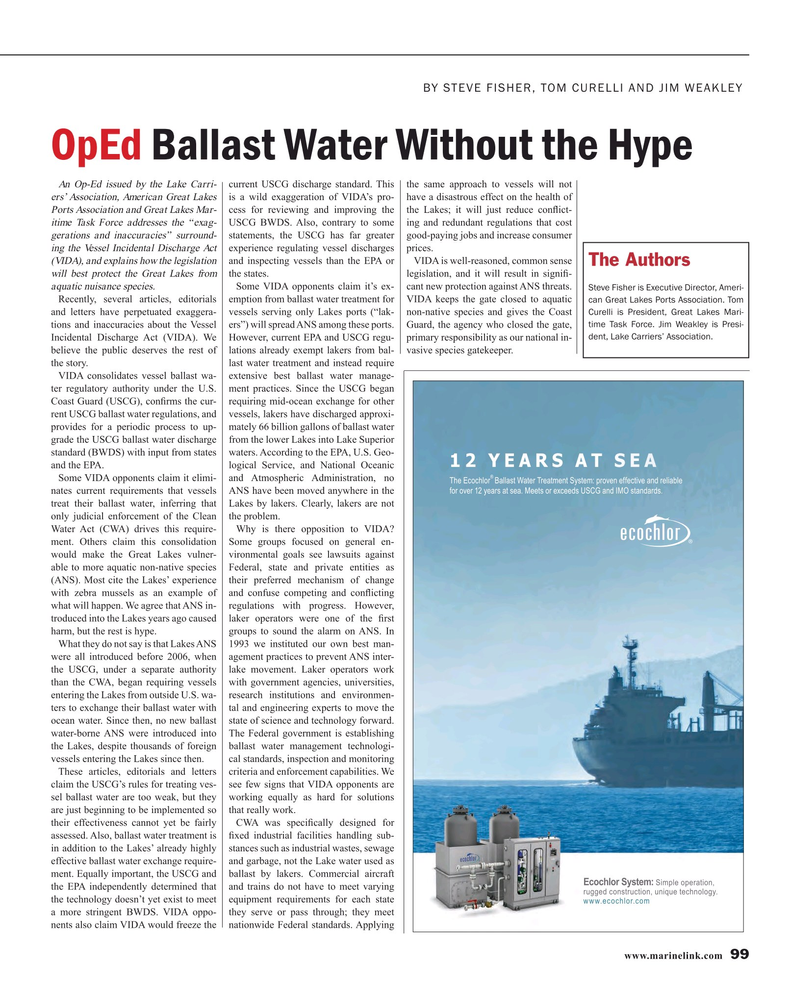
Page 99: of Maritime Reporter Magazine (August 2016)
The Shipyard Edition
Read this page in Pdf, Flash or Html5 edition of August 2016 Maritime Reporter Magazine
BY STEVE FISHER, TOM CURELLI AND JIM WEAKLEY
OpEd Ballast Water Without the Hype
An Op-Ed issued by the Lake Carri- current USCG discharge standard. This the same approach to vessels will not ers’ Association, American Great Lakes is a wild exaggeration of VIDA’s pro- have a disastrous effect on the health of
Ports Association and Great Lakes Mar- cess for reviewing and improving the the Lakes; it will just reduce con? ict- itime Task Force addresses the “exag- USCG BWDS. Also, contrary to some ing and redundant regulations that cost gerations and inaccuracies” surround- statements, the USCG has far greater good-paying jobs and increase consumer ing the Vessel Incidental Discharge Act experience regulating vessel discharges prices.
(VIDA), and explains how the legislation and inspecting vessels than the EPA or VIDA is well-reasoned, common sense
The Authors will best protect the Great Lakes from the states. legislation, and it will result in signi? - aquatic nuisance species. Some VIDA opponents claim it’s ex- cant new protection against ANS threats.
Steve Fisher is Executive Director, Ameri-
Recently, several articles, editorials emption from ballast water treatment for VIDA keeps the gate closed to aquatic can Great Lakes Ports Association. Tom
Curelli is President, Great Lakes Mari- and letters have perpetuated exaggera- vessels serving only Lakes ports (“lak- non-native species and gives the Coast time Task Force. Jim Weakley is Presi- tions and inaccuracies about the Vessel ers”) will spread ANS among these ports. Guard, the agency who closed the gate, dent, Lake Carriers’ Association.
Incidental Discharge Act (VIDA). We However, current EPA and USCG regu- primary responsibility as our national in- believe the public deserves the rest of lations already exempt lakers from bal- vasive species gatekeeper.
the story. last water treatment and instead require
VIDA consolidates vessel ballast wa- extensive best ballast water manage- ter regulatory authority under the U.S. ment practices. Since the USCG began
Coast Guard (USCG), con? rms the cur- requiring mid-ocean exchange for other rent USCG ballast water regulations, and vessels, lakers have discharged approxi- provides for a periodic process to up- mately 66 billion gallons of ballast water grade the USCG ballast water discharge from the lower Lakes into Lake Superior standard (BWDS) with input from states waters. According to the EPA, U.S. Geo- 12 YEARS AT S E A and the EPA. logical Service, and National Oceanic ®
Some VIDA opponents claim it elimi- and Atmospheric Administration, no
The Ecochlor Ballast Water Treatment System: proven effective and reliable for over 12 years at sea. Meets or exceeds USCG and IMO standards.
nates current requirements that vessels ANS have been moved anywhere in the treat their ballast water, inferring that Lakes by lakers. Clearly, lakers are not only judicial enforcement of the Clean the problem.
Water Act (CWA) drives this require- Why is there opposition to VIDA? ment. Others claim this consolidation Some groups focused on general en- would make the Great Lakes vulner- vironmental goals see lawsuits against able to more aquatic non-native species Federal, state and private entities as (ANS). Most cite the Lakes’ experience their preferred mechanism of change with zebra mussels as an example of and confuse competing and con? icting what will happen. We agree that ANS in- regulations with progress. However, troduced into the Lakes years ago caused laker operators were one of the ? rst harm, but the rest is hype. groups to sound the alarm on ANS. In
What they do not say is that Lakes ANS 1993 we instituted our own best man- were all introduced before 2006, when agement practices to prevent ANS inter- the USCG, under a separate authority lake movement. Laker operators work than the CWA, began requiring vessels with government agencies, universities, entering the Lakes from outside U.S. wa- research institutions and environmen- ters to exchange their ballast water with tal and engineering experts to move the ocean water. Since then, no new ballast state of science and technology forward. water-borne ANS were introduced into The Federal government is establishing the Lakes, despite thousands of foreign ballast water management technologi- vessels entering the Lakes since then. cal standards, inspection and monitoring
These articles, editorials and letters criteria and enforcement capabilities. We claim the USCG’s rules for treating ves- see few signs that VIDA opponents are sel ballast water are too weak, but they working equally as hard for solutions are just beginning to be implemented so that really work.
their effectiveness cannot yet be fairly CWA was speci? cally designed for assessed. Also, ballast water treatment is ? xed industrial facilities handling sub- in addition to the Lakes’ already highly stances such as industrial wastes, sewage effective ballast water exchange require- and garbage, not the Lake water used as ment. Equally important, the USCG and ballast by lakers. Commercial aircraft
Ecochlor System: Simple operation, the EPA independently determined that and trains do not have to meet varying rugged construction, unique technology.
the technology doesn’t yet exist to meet equipment requirements for each state www.ecochlor.com a more stringent BWDS. VIDA oppo- they serve or pass through; they meet nents also claim VIDA would freeze the nationwide Federal standards. Applying www.marinelink.com 99
MR #8 (98-105).indd 99 8/2/2016 3:34:43 PM

 98
98

 100
100
